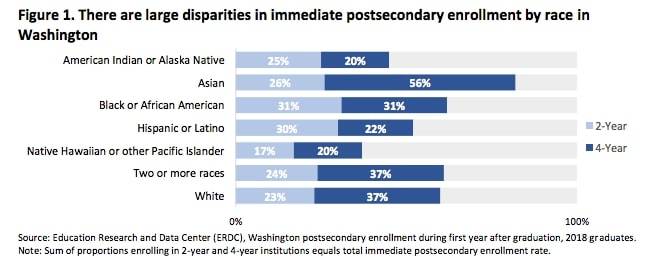The Washington Student Achievement Council (WSAC) met Aug. 23 to discuss legislative proposals to meet the state’s goals of getting 70% of Washington to have some form of post-secondary education.
The proposals are looking to address some of the barriers that inhibit Washingtonians from seeking higher education through a four-year, two-year or technical program. The legislation particularly targeted low-income students and students of color, who have been most heavily affected by the COVID-19 pandemic.
“An issue I hear over and over again is why Washington, with everything it has going for it, has a college going rate that is ten points below the national average,” said Michael Meotti, executive director of the WSAC. “Year after year, we see a decline in adults enrolling, particularly in community and technical colleges. This is trying to get at that issue.”
According to the National Center for Higher Education Management Systems, 53% of 2018 high school graduates in Washington state went directly into college the following year. Rates were significantly lower for Indigenous and Latino populations.
In 2018, Washington had the fifth worst rate of immediate college enrollment in the nation, ahead of only Arizona, Utah, Idaho and Alaska. Washington has not been above the national average since 1994, when 57.4% of high school graduates immediately went on to college.
According to the Education and Research Data Center, about 78% of seniors at Mount Si High School in the Snoqualmie Valley School District immediately enrolled in some form of secondary education upon graduation in 2019, which is up from 60% in 2005. In the same time span, the number of Mount Si seniors immediately enrolling in a four-year program has risen 31%, while those enrolling in community colleges or trade schools has dropped 13%.
College enrollment, which had remained stagnant for a number of years statewide, has worsened due to the pandemic. In the fall of 2020, college enrollment was down 13% from the prior year.
FAFSA applications, a key indicator of enrollment, are down across the board. By March 2021, only 39% of state seniors had completed a FAFSA application, which is down 5% from 2020.
“The opportunity we see to address this issue is not to follow the notion of the state picking a single solution, but instead to take a look at what’s happening around our state that is changing these traditional patterns,” Meotti said.
The council has proposed a list of programs with goals of helping students enroll and stay in college. One of these programs is a scholarship initiative that includes $250 million for scholarships to disadvantaged students over the next decade.
“This is not just an allocation program. We want standards,” Meotti said. “We want to close racial and ethnic gaps.”
Another program creates 300 work-study jobs for current college students, to work as advisors for current and incoming students. The council is also looking at creating a new app and expanding current communication platforms to ease the process of applying for college and financial aid.
The council is also proposing to fully fund college in high school courses and Running Start programs for low-income students.
The state found that low-income and minority students are less likely to participate in these programs, likely due to additional costs, which further increase income inequality. Students who do participate in these programs are found to be more likely to attend college.
In addition to enrollment, the state is looking at ways to meet the basic needs of college students. The council is expanding its homeless student pilot program, which provides financial support for college students experiencing homeless. They are also planning to create a survey that looks at the needs of students, in regards to food, housing, health care and internet access, at different schools.
The council found that Indigenous, Latino and Black students were between 7% to 16% more likely to struggle with food insecurity when compared to white students, which inhibited college enrollment numbers. They also faced higher rates of housing insecurity.
“We need to learn from all our institutions. They’re all unique,” said Heather Hudson, WSAC director of planning and policy. “With the pandemic, we have seen students facing housing insecurity exacerbated.”
Talk to us
Please share your story tips by emailing editor@kentreporter.com.
To share your opinion for publication, submit a letter through our website https://www.kentreporter.com/submit-letter/. Include your name, address and daytime phone number. (We’ll only publish your name and hometown.) Please keep letters to 300 words or less.

